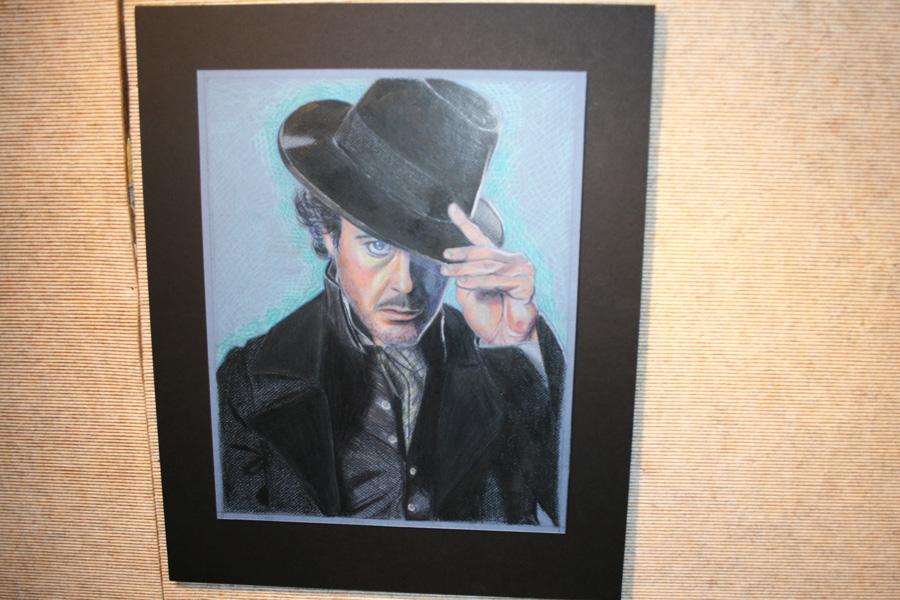Six senior art majors—five Japanese women and one American woman with an eye for Japanese inspiration—displayed the culmination of their studies in the Bradley building on Friday, March 1 for their senior art exhibit.
The event was well-attended and gave the women an opportunity to display all types of art, including paintings, colored pencil drawings, three-dimensional sculptures, photographs, charcoal drawings, digital art, and creative product packaging concepts.
The senior art majors were Hiroe Terasawa, Ayaka Aso, Yuko Mamiya, Mai Tanaka, Kazuyo Nikkawa, and the only American student of the group Sirin Avci. Each woman shared a little about her background and inspirations so that those present could better appreciate the stories behind the paint, ink, clay, and paper.
Terasawa told her listeners, “My passion of drawing started since I was a child.” Her grandfather is a talented oil painter to whom she looks up. She recalled her childhood home where her grandfather’s paintings were often displayed.
Terasawa is also inspired by her mother’s paintings and drawings, which is perhaps why she favors colored pencils and oil paints in her work.
One of her most prized works of art is a colored pencil drawing of Johnny Depp. “Because of this picture, I got confident,” she said.
Far from being enamored with paints and pencils, Aso laughingly told her audience, “I don’t like paintings and drawings because I am lazy. I get tired of doing something for so long.”
Aso prefers to produce digital art, take photos, and design her blog.
“Some people say that art is self-satisfaction,” said Aso, “but I don’t think so; art will be art when other people recognize it as art.”
Indeed, as Associate Professor of Art William Weidner pointed out, Aso has a knack for recognizing art in unlikely places.
“I don’t like taking pictures of people,” said Aso, “so my focus may be on the texture of the clothes.”
While Aso focuses on subtle textures, Mamiya loves to work with a variety of colors to bring her artwork to life.
“I think color is a very important part of artworks,” said Mamiya. “Each color has different meanings and emotions.” Mamiya found expression through art despite that she still feels that her spoken English is a bit rough.
“Just studying here is a big challenge for me,” said Mamiya.
“Denise [Presnell-Weidner, associate professor of art,] helped me,” said Mamiya. “Also Dr. [Russell] Pettitt [assistant professor of music] always cheered me up.”
Weidner observed that Mamiya’s colorful paintings portrayed more than just assignments, but also a “personalized private world.”
Next to explain her work was Tanaka, whose imaginative drawings included vibrant colors and themes seemingly taken straight from children’s dreams.
“I’ve liked drawings and illustrations since I was a child,” said Tanaka. She showed the audience her illustrations meant for a children’s book about a friendly-looking pink monster from under the bed.
Presnell-Weidner said of Tanaka’s variety of intricate art, “[Tanaka] has a strong sensitivity to abstract design.”
On the other hand, Nikkawa’s forte seems to lean towards more realistic portrayals of life, including some landscapes and portraits.
“I’ve liked drawing pictures since I was a little girl,” said Nikkawa. “I just want to show things that are beautiful for everyone.”
When Nikkawa started at Lakeland College Japan, her intended major was business. But, after she took Drawing 1 and realized how much she loved drawing pictures, she changed her major to art.
Weidner says that Nikkawa “takes everything very seriously from beginning to end.”
He estimates that she takes at least double the required six hours per week of class time to finish and perfect her art.
Last to present her work was Avci, who has known of her love for art—particularly graphic design—for a long time.
“As far back as I can remember,” said Avci, “I filled up notebooks with doodles and drawings.”
Later, Avci discovered she also has a love for taking photos and playing with editing and color in Photoshop.
Presnell-Weidner says Avci has a “good eye for abstraction and for color.”
“I have a hard time doing something if I’m not passionate about it, so there are lots of random things,” said Avci as she observed the audience looking around at her diverse display of art.
When asked by a Japanese student about her Japanese style elements, Avci responded that she is “big into anime conventions,” so her art is influenced by the style of famous Japanese anime.
The art of these women testified to the variety of techniques and mediums that Lakeland’s art students have the opportunity to learn. And yet, the similarities and the mutual enjoyment of the art showed that no art student is an island.


